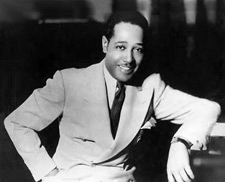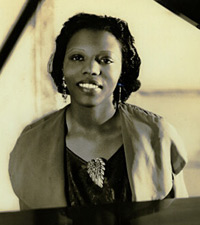Of all the popular music forms, jazz is one of the very few that – on the surface, at least – evinces little overtly Christian content. Take a closer look, and it quickly becomes clear there’s a deep spirituality inherent within the music itself.
The roots of jazz are in ragtime, blues, gospel, and the black spirituals of the late 1800s; and while the genre has gone through countless transformations over the last century, for the most part it’s possible to find traces of each of those forms in every era.
There’s a longstanding, ongoing relationship between gospel and jazz. Many of the music’s pioneers recorded spirit-infused music.

Considered the father of jazz – and, many would argue, the most important and influential musician in jazz history – Louis Armstrong included gospel in his repertoire throughout his entire career.
His earliest efforts were originally released on individual 78s, but Hallelujah! Gospel 1930-1941 manages to collect 17 together on one CD.
With the advent of the LP record, he began releasing full-length efforts, including 1957’s Louis and the Angels, followed a year later by Louis and the Good Book.
His final album, Louis Armstrong and His Friends, had Father Norman O’Conner, known as ‘The Jazz Priest,’ singing along on ‘We Shall Overcome.’ The album includes a version of the posthumous hit, ‘What A Wonderful World,’ during which Armstrong addresses the younger generation; “See what a wonderful world it would be if only we’d give it a chance…love, baby, love. That’s the secret…”
The inclusion of ‘The Creator Has A Master Plan,’ by Pharaoh Sanders, a leading light in the radical New Jazz scene, was a rare example of bridging the sometimes contentious gap between the two camps.

Duke Ellington was undoubtedly one of the century’s most important composers. His first major extended piece, Black, Brown and Beige, was a gospel-inspired suite that debuted in Carnegie Hall in 1943. It included one of his most popular pieces, ‘Come Sunday’ as it’s centerpiece.
He revisited the almost hour-long piece repeatedly throughout his career, and in 1958 recorded a version with gospel legend Mahalia Jackson singing.
Ellington – who once described himself humorously as a ‘messenger boy from God’ – was a longtime churchgoer who studied scripture his entire life. He frequently employed the language of faith in his compositions, and decried denominational differences, lamenting “Catholics against Protestants against Jews – and all of them against the Negro.”
Twenty years after Black, Brown, and Beige, Ellington began performing what he described as “the most important thing I’ve done”: a series of Biblically-based Sacred Concerts.
The endeavor was viewed by many as a creative resurgence. One piece from the first concert; ‘In the Beginning, God’ won a Grammy for best original jazz composition in 1966. The final Sacred Concert, entitled ‘The Majesty of God,’ was held in 1973, only seven months before his death.

Considered the most influential woman in the history of jazz music, pianist and composer Mary Lou Williams played, wrote and arranged for Ellington, Benny Goodman, Dizzy Gillespie and others before embracing Catholicism in 1952.
She left music for a few years, but returned in 1957 after priests and fellow musicians convinced her she could serve God best through her music. In spite of a flourishing career, she remained closely involved in numerous outreaches – including heading up a ministry helping addicted musicians to get straight, and managing thrift stores in New York City.
She composed sacred works for orchestras, including three masses, a cantata, and a number of hymns. 1963’s Black Christ in the Andes – a suite dedicated to the 16th century Afro-Peruvian Priest St. Martin de Porres that incorporated jazz, gospel and blues – was typical of her work from the era. In a Time Magazine profile the following year, Williams spoke of praying through her fingers when she played.
Many recorded music directly associated with the gospel message. For some innovators – like Dave Brubeck and big band leader Stan Kenton, it was – not surprisingly – ambitious, multi-part works; Kenton released a double LP based on the Beatitudes, and Brubeck composed Truth Is Fallen, a Cantata based on Isaiah, in 1972.
During the swing era, ‘I Hope Gabriel Likes My Music’ was a popular hit, covered by big bands of the day, including Armstrong, Paul Whiteman and Gene Krupa. Krupa – by far the most popular drummer of his day – became active in the church near the end of his life.
Others chose more traditional material. While the songs might be familiar, opportunities for improvisation ensure there’s room for personal expression even on the most well-known numbers.
Horace Silver owed much of his hard bop sound to gospel music. One of his earliest, and most popular tunes was ‘The Preacher,’ from 1955. Thelonious Monk – one of the most unique voices in jazz – opened Monk’s Music with a respectful rendition of the hymn ‘Abide With Me’ two years later.
Bebop pianist Hampton Hawes and guitarist Grant Green both grew up playing in the church (Hawes’ father was a minister in the Presbyterian Church) and each struggled with drug addiction throughout their lives.
Green performed gospel and spirituals for Sunday Mornin’ in 1962, his first year as a recording artist, and again on Feelin’ the Spirit the following year.
Hawes recorded The Sermon, a deeply reverential treatment of old time spirituals on the eve of a 1958 heroin-related jail sentence. Due to his incarceration, the album laid in the vaults. He was pardoned by President Kennedy five years later, but his label wanted new product by then. The Sermon finally saw release in 1987, ten years after Hawes’ death.
Charles Mingus and Ornette Coleman were also influenced by backgrounds in the church; Coleman claimed his formative years spent playing in the Spiritual Churches of New Orleans informed everything that came after, and the Mingus connection is most apparent in compositions like 1960’s ‘Wednesday Night Prayer Meeting,’ which comes across like a particularly rambunctious service, and ‘Prayer for Passive Resistance’ which focused on the civil rights struggle with an awareness that there was more going on than met the eye.
The sixties saw a cultural sea change that included an unprecedented openness to spiritual matters. That shift – which lasted well into the seventies – was reflected in the jazz community.
During the first three years of the decade, trumpeter Donald Byrd released ‘Pentecostal Feeling,’ ‘Amen,’ and ‘Christo Redentor’ – also known as ‘Christo Redemptor.’ Duke Pearson – the latter song’s composer – is featured alongside Byrd, Lou Donaldson, Hank Mobley and others on The Blue Testament – Blue Note Plays the Good Book, a British anthology that offers ample evidence gospel’s role in jazz during the era.
The adventurous free jazz movement of the 1960s placed a great amount of import on spiritual matters.
John Coltrane and Albert Ayler each followed rigid spiritual paths that incorporated Christian and Eastern elements, and owed much of their sound and approach to lessons learned in the church.
Ayler’s discography is full of titles like ‘Light in the Darkness,’ ‘Spiritual Rebirth,’ and ‘Omega is the Alpha.’ On the mammoth Holy Ghost (Revenant Records) – a nine-disc collection of rarities – he speaks of coming days; “Thus through Jesus Christ we will all be saved through the Holy Father, the Infinite Spirit, the Creator of all. Blessed is all who believe in the Lord…and we all know that Jesus is coming again, so fear ye not, the great sacrifice is yet to come.”
John Coltrane’s most highly regarded work, 1964’s A Love Supreme, was a four-part spiritual opus (Acknowledgement /Resolution/Pursuance/Psalm) composed as a gift to God. The album included a note to the listener that began; “All Praise Be To God To Whom All Praise In Due. Let us pursue Him in the righteous path. Yes, it is true; ‘seek and ye shall find.’ Only through Him can we know the most wondrous bequeathal.”
Coltrane’s impact on subsequent generations was profound; there’s even a Saint John Coltrane Church located in San Francisco. Since his death over forty year ago, no one has come close to impacting the scene so profoundly.
After first making a name for himself performing alongside Coltrane, Pharaoh Sanders went on to produce a number of spiritually-inspired epics himself, including ‘Let Us Go Into the House of the Lord,’ ‘Selflessness,’ and ‘The Creator Has A Master Plan,’ which clocked in at over half an hour.
Soul Jazz took much of it’s sound from gospel, and was far more popular with the public. Cannonbal Adderley enjoyed hits with ‘Work Song,’ ‘Country Preacher,’ and a cover of the Staple Singers’ ‘Why Am I Treated So Bad,’ while Ramsey Lewis had a top forty hit with ‘Wade in the Water.’
Multi-instrumentalist Rahsaan Roland Kirk performed an intense version of ‘Old Rugged Cross’ 1971, the same year Stanley Turrentine recorded the traditional gospel tune ‘I Told Jesus.’
Another of the leading lights from the new jazz scene, sax player Archie Shepp teamed with pianist Horace Parlan in 1977 to record Goin’ Home, a collection of spirituals and black folk songs.
The seventies brought about the fusion movement, mixing high energy rock with jazz chops. Many of the groups, including Mahavishnu Orchestra, Return To Forever and Santana – were very direct in promoting spiritual agendas, although in almost every case the religions espoused – Scientology, Eastern Mysticism, Chanting – rejected traditional Christian doctrine.
Reflecting the cultural climate once again, by the eighties jazz had become more conservative. Fewer musicians were incorporating direct spiritual references, although there were some notable exceptions.
In 1984 Oscar Peterson composed the Easter Suite, an eight-movement of Christ’s last days, and Charlie Haden and Hank Jones teamed up for Steal Away, an album of spirituals, hymns and folk songs in 1995.
A handful of younger players are keeping the tradition alive; in the last decade, pianist Cyrus Chestnut – whose gospel background in evident in all of his playing – released Blessed Quietness: A Collection of Hymns, Spirituals and Carols and saxophonist Kirk Whalum – who grew up playing in his father’s church choir – has released a number of albums reflecting his faith, including two volumes of The Gospel According to Jazz. Branford Marsalis has reached back to John Coltrane, and recorded A Love Supreme, on two separate occasions.
© John Cody 2008
